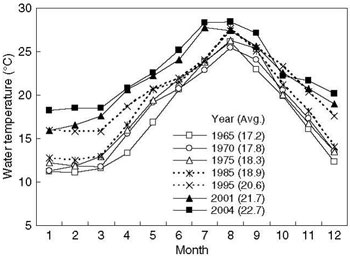CADDIS Volume 2: Sources, Stressors & Responses

Urbanization & stream temperature
Urbanization often results in increased stream temperatures (e.g., increased daily maximum temperature, increased number of temperature exceedances), especially in summer. This is due in part to the formation of urban heat islands, or localized areas of heat storage (and warmer air temperatures) near urban centers. Many other aspects of urbanization also can contribute to stream warming:

Riparian alteration can reduce canopy cover and shading, increasing solar radiation reaching the water surface.
Wastewater inputs can lead to the direct discharge of warmer effluents into stream and rivers (Figs 26 and 27).
Stormwater runoff from warm impervious surfaces can contribute heated surface runoff to surface waters, and reduce cooler groundwater inputs via decreased infiltration.
Lower baseflows can lead to shallower water and standing pools, which warm quickly.
Physical habitat changes such as channel widening can increase channel width:depth ratios, further reducing riparian shading and increasing surface area for heat exchange.
Certain best management practices (BMPs) for urban streams, such as stormwater retention ponds, can increase water retention time and warming, particularly in unshaded systems.
Increases in water temperature also can affect other urban-associated stressors:
Water/sediment quality – via decreased dissolved oxygen saturation, increased ammonia toxicity, and increased biotic uptake of toxic substances
Energy sources – via increased microbial respiration and primary production
Elevated water temperatures can be stressful to aquatic organisms, and may result in numerous lethal and sublethal effects (e.g., death, increased disease susceptibility, and decreased growth and reproduction). See the Temperature module for further discussion of temperature as a cause of stream impairment.
Click below for more information on specific topics




From Kinouchi T. 2007. Impact of long-term water and energy consumption in Tokyo on wastewater effluent: implications for the thermal degradation of urban streams. Hydrological Processes 21:1207-1216. Reprinted with permission.

From Kinouchi T et al. 2007. Increase in stream temperature related to anthropogenic heat input from urban wastewater. Journal of Hydrology 335:78-88. Reprinted with permission from Elsevier.
